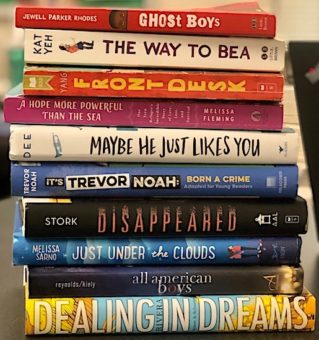Sharing the Joy of Reading with Students
Providing choice, time and accountability for independent reading

Independent reading provides students an opportunity to build vocabulary, increase comprehension, and build confidence, while fostering a love of reading.
However, it can be challenging to motivate middle grades students and hold them accountable without turning free reading into a laborious process for both the student and teacher.
I have found that helping students find the right book, using authentic assignments for accountability, and providing the time to read helps to build a classroom climate where reading is valued and enjoyed.
Providing True Choice
For students to truly have choice in what they read, they need access to a variety of high interest books with diverse themes, formats and characters as well as resources to get recommendations for books they may like.
I show students examples of where they can go to get books such as the school library, public library print and digital books, and my classroom library. I also encourage students to share books they enjoyed with their classmates.
In order to get students interested in different books, I give book talks within my middle school classroom. The talks are often informal, quick breaks from my lesson, where I show them a book or two in my classroom library and talk to them about why I enjoyed it.
Students also participate in “book tastings” where they travel around the room spending a few minutes with each book. During this time they examine the peritext (the chapter titles, cover images, descriptions, blurbs, etc.) and make notes of any books they may be interested in reading later.
If they come across a book they have already read, they are asked to create their own epitext for the book by writing a review on a sticky note and placing it inside the front cover.
I model myself as a reader and always having a stack of books on my desk that I recently read and recommend. I also provide students various opportunities to recommend books to each other such as:
• #AmReading post – Students print out a twitter length book recommendation with a picture of the book to post in my classroom.
• Library catalog review – Students post a few sentences reviewing books they read from the school library on the online library site that is available for other students to view.
• Discussion – I set aside time for students to talk about what they are reading in small groups and give recommendations to their peers.
• Student-led book talks – On request, students are always given a few minutes to share out a book they particularly enjoyed with the class.
• I have a space on my bookshelf for students to place books they would recommend to their peers and are willing to lend to anyone in the class who would like to read it.
I consistently remind students that I want them to read something they’ll enjoy – that there are too many wonderful books in the world to spend time reading something they don’t like. If they are not enjoying a book, they know they can abandon it. As a way to model, when I come across a book that I am not enjoying, I will share with students that I am abandoning it and why it just wasn’t the right book for me.
If students find themselves enjoying a book from a series, I encourage them to read the entire series if that is something they want to do. I understand the temptation to try and encourage them to branch out and read something else, but I also value their dedication in following through with an entire story line.
Authentic Accountability

Informally I am consistently checking in with them to ask them about their book and challenging them to make connections to the book. They start to realize fairly quickly that I notice if they have been reading and that they can’t fake it.
I also alternate between structured forms of accountability such as book reviews. Throughout the year students may write a book review for their peers or a public site, create a book review video or podcast, and give live book talks to their classmates. These book reviews are not designed as book reports but as opportunities to share with others what they really thought about the book and why.
Throughout the year I also have students do quick writing prompts where they digitally submit to me what page they are on and tell me something about what they are reading.
While I prefer in-person discussions, sometimes due to time I need to quickly be able to check in with all of the students. There is also a quick whole class activity that I call making a “Reading Web” where one student stands up and shares one thing about their book, then another student stands up who can connect that fact to something about their book, and so on until everyone has connected their book to someone else’s book.
Time to Read
Maybe the most important thing I do to encourage students to read is to make time for reading. To create this time I frequently assign reading-only homework nights. On these nights I ask students to read around a minimum 15 minutes but encourage them not to time themselves.
Instead they are asked to set aside some time to spend with their book and see how long it holds their interest. If it is not holding their interest, I will work with them to figure out if they need to abandon their book or eliminate other distractions during their reading time.
I also provide time in class to allow them to read and talk about reading. For students who are really busy with extracurricular activities, I work with them to find times in their day to read such as after finishing assignments in school, study hall, while riding in a bus or car, before bed, when they first wake up, etc.
Once students find a book they are invested in and are given time to read, they begin to build consistent reading habits and see reading as something they want to do instead of something they have to do.
Kasey Short (@shortisweet3) attended the University of North Carolina at Chapel Hill and earned a bachelor of arts in middle school education with a concentration in English and history. She went on to earn a master’s of education in curriculum and instruction from Winthrop University. She is currently an eighth grade English teacher as well as English Department chair at Charlotte (NC) Country Day School.































Kasey,
Finally, an article on motivating students to read that is full of inventive ideas. I will send it on to fellow educators. Thank you.